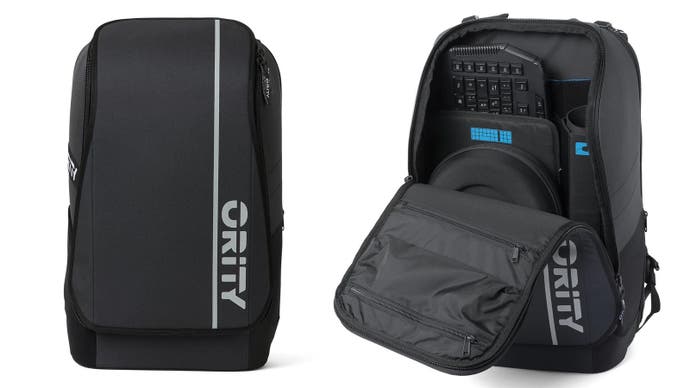I bought Puma's ?80 esports shoes so you don't have to: Active Gaming Footwear review
Plus: which esports equipment is actually worth it.
Just before Christmas, sportswear giant Puma announced its first products designed explicitly for esports. Called "Active Gaming Footwear", these lightweight socks cost $105/£80 and are designed to be used indoors and in esports arenas, providing the comfort, support and grip that professional gamers need to compete at the highest level. This sounds to me like complete bollocks - and that's why I knew I needed to buy them.
You see, people have been selling utterly useless "pro gaming" gear for absolutely ages. Even in the early days of esports, when Twitch was still called Justin.tv and StarCraft 2 was the biggest game in the scene, professional players would be hauled in front of a camera to shill stuff like oversized, overpriced racing chairs or piss-yellow gaming glasses that made wearers look like off-brand rent-a-cops. Delivering their lines with the clumsy charisma of a professional footballer asked for their opinion on the Iran-Contra crisis, these folks would swear up and down that you too could make it to the big leagues if you plonked down $199 for a XtreemPro 360 gaming towel with extra sweat rivulets and an inner lining made from Mongolian yak hide.
I knew that it was all nonsense, but a small part of me still wanted to believe there was a grain of truth behind the marketing - that maybe you could find that critical one per cent of extra performance from an unexpected source. Now, I had the perfect chance to disabuse myself of that ridiculous notion once and for all - by ordering these shoes and actually testing them in-game.
The esports trainers arrived on my doorstep a few days later. Taking them out of the box, the generic "footwear" designation immediately made a lot more sense. In the same way that many American ice creams can only be legally labelled as "frozen dairy product", describing the Active Gaming Footwear as shoes would be going too far. After all, calling something a shoe implies some sort of structural rigidity, whereas the AGF deflated like a punctured puffer fish once the packed tissue paper and cardboard supports were removed. It's more accurate to call them socks, perhaps, or "generic foot coverings", with a knitted upper sitting atop a very slim rubber sole emblazoned with the phrase "designed to the requirements of active gaming".
Executing on that tough design brief largely meant removing functionality, apparently, with the box warning buyers that these shoes are designed for indoor use only - you can use these at home or walking from the player area to an esports stage, but you can't go into the garden with footwear of this quality!
One of the most enticing parts of the Active Gaming Footwear proposition came on its product page, which promises four different all-caps "modes": SEEK, ATTACK, CRUISE and DEFENSE, each providing a different element of grip, support and stability. Unfortunately, these modes are just marketing nonsense; the shoes can only be worn one way and there's not even a useless mode selector switch or something to pay lip service to the product description. I didn't expect that the shoes would start driving around on their own in SEEK mode, but even an RGB light with different effects would have been nice!
Of course, the AGF could still live up to their name by delivering excellent performance in-game... so I loaded up Counter-Strike, my competitive game of choice, and hopped onto a Dust 2 deathmatch server. I played a little without the shoes on, to warm up and get a baseline measure of my performance, then I put the Pumas on as the computer loaded the next round.
I don't know why, but I immediately felt more focused - more engaged. I sat straighter in my chair, pulled the screen to within a few inches of my face and started fragging. It was weird - enemies seemed to hesitate in my crosshair for a splitsecond, giving me the chance to line up a clean headshot and send them to the respawn screen. No matter where I went or which weapon I pulled out, I felt untouchable. AWP collaterals, nutty Deagle headshots and AK-47 sprays for days, it all just worked.
By the time the end-of-game scoreboard appeared, I'd set a new personal record - 55 kills and 660 points in 10 minutes. I put in a triumphant "gg!" in chat, waiting for the accolades to roll in. Only one player spoke:
Verok: lol
Verok: bot game
He was right - he was the only other human player on the server.
Of course, it's not a great surprise that the purpose-built gaming footwear doesn't improve performance in what is largely a hand-eye operation. I repeated the test in a competitive match, just to be sure, and once again I felt no better prepared with the Pumas on as with any other foot covering - or even none at all.
So no, the Active Gaming Footwear won't improve your performance. They're just comfy, indoor-only foot wraps, somewhere between a sock and a shoe. To say that another way: they're slippers. Fancy, sportswear-inspired, $105 slippers. For that money, you could get an extra pair of trainers to wear indoors if that feels right for you, and still have money left over for actual slippers to wear in the winter months. But just because these pro gaming socks are a farce, it doesn't mean that all non-digital equipment marketed to the esports market is too.

Here's one example: over the past few months I've been testing out the Ority esports backpack. The idea is that it's a bag large enough to actually fit all of the PC peripherals you'd need to take to a LAN party or esports tournament, including separate compartments for a 17-inch gaming laptop, a full-format mechanical keyboard, oversized headphones and a rolled-up mouse mat. I've taken it whenever I've travelled for work, and I've loved having easy access to all of my peripherals (and their many cables) without worrying they'll get scratched or dented in the bottom of my bag. I would have absolutely killed for a backpack like this when I attended LAN parties more regularly - and judging by the frequent peripheral failures experienced by professional gamers on the big stage, the Ority wouldn't go amiss for them, either.

I wouldn't recommend this bag to everybody - its size and weight make it a real commitment and similarly large bags without the custom internals are much cheaper - but it is perfectly suited for the small segment of the population that it's marketed towards. That's what makes it a successful esports product in my mind - and by the same token, why Puma's Active Gaming Footwear is just a pretender.
That doesn't mean that these shoes are awful and no one should buy them - it's just that marketing something as "created with console gamers in mind" and then including no console gaming features or characteristics doesn't make sense. As a lightweight shoe for AR and VR gaming? Sure. A grippy sock for DDR enthusiasts? Definitely, I could see that. But for the sort of professional gaming that takes place in arenas, this shoe ain't it chief.
If you are looking to get better at video games, here's my recommendation: stick to the products that actually matter. That means headsets and gamepads on consoles, plus mice and keyboards on PC. A higher frame-rate can also make games easier, so unlock that with a faster graphics card and then make use of it with a high refresh rate, low input lag monitor. Once you've got these elements sorted, then you can start hitting your peak as a competitive gamer - and after you've won some prize money, maybe Puma's esports shoes will come in handy.






